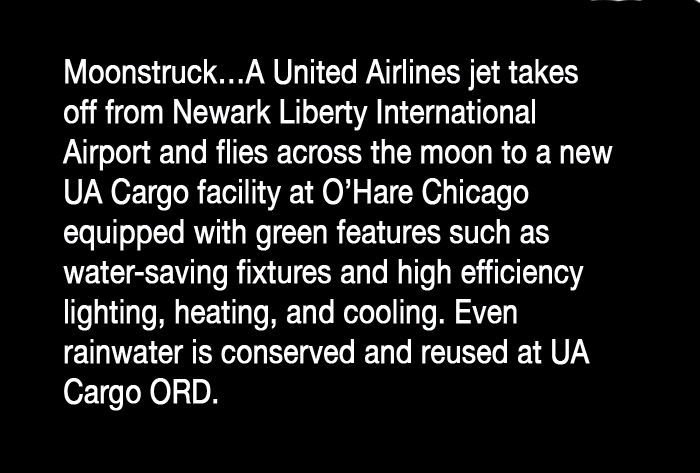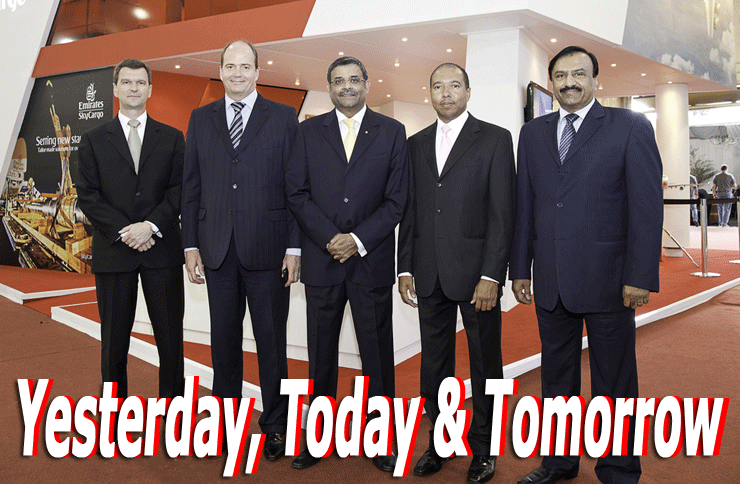
Two views of Hong Kong International Airport Sky City, as dreams of
bringing a real live Aerotropolis to Middle America continue.
 Editor's
Note: Just like the Blue Fairy once granted a wish upon a star in Walt
Disney’s Pinocchio, Aerotropolis as deliverance to gateway greatness
is still out there in the air. Editor's
Note: Just like the Blue Fairy once granted a wish upon a star in Walt
Disney’s Pinocchio, Aerotropolis as deliverance to gateway greatness
is still out there in the air.
As we say in New York City, “If
wishes were only knishes.”
However you spin or slice it, wishing
for Aerotropolis didn’t make a difference when St. Louis Lambert
Field’s bid tanked big time late last year.
But when major politicos and mega-money
are on the table, what goes around comes around.
Here, Michael Webber, who single-handedly
took down the St. Louis project, brings us up to date with what else
might be going on at some gateways in middle America as we move into
Spring 2012.
In terms of total disclosure, Missouri-based
Michael does some consulting work for Chicago O’Hare International
Airport.
ORD, the last time we checked, was still
the address of every important, all cargo flight outside of Memphis
in heartland USA.
In early April 2012, the St. Clair (Illinois)
County Public Building Commission demanded that former Wall Street executive
John Hewitt return a $250,000 taxpayer-funded incentive originally intended
to facilitate development of what was to be a $6 million, 62,500 square-foot
warehouse at MidAmerica St. Louis Airport (located in Mascoutah, Illinois).
How the deal came to the point of collapse is a story of consistently
failed accountability at the airport, county, and federal levels.
The cancellation follows the County’s
acceptance of a dramatically scaled back plan that reduced the warehouse
to only 30,000 square-feet (no longer including a chiller) at a cost
of about $2.5 million. In spite of reducing private investment by more
than half, the revised deal retained the $250,000 public subsidy which
the airport’s director, Tim Cantwell, still described as a good
deal—satisfied that Hewitt had “proven that he has some
partners, and he does have a user for the building.” Recent events
have only illuminated Cantwell’s chronic deficiencies as a judge
of proven partners and users. When Hewitt was first introduced as MidAmerica’s
prospective developer, Cantwell’s characterization of the vetting
process was “on this regard, we have researched this as much as
we could. And we had him in front of the airport committee of the building
commission on a number of personal reviews.” Yet Cantwell and
his Board seemed blindsided when the Belleville News-Democrat reported
in July 2011 that the Internal Revenue Service, joined by the state
and city of New York, had filed more than $855,000 in tax liens against
properties owned by Hewitt’s H-Trading for nonpayment of personal
income taxes.
Not for the first time, federal taxpayers
have also been roped into subsidizing what miserably passes for oversight
at MidAmerica. In March 2011, the Building Commission approved a doubling
of MidAmerica’s cargo apron with 95 percent of the $2.24 million
project coming from the FAA’s Airport Improvement Program. According
to FAA spokeswoman Elizabeth Isham Cory, the timing of the larger grant
for ramp expansion was precipitated by the County’s signing of
a lease with a developer (Hewitt) to build a second warehouse at the
airport. “The money’s being released because the airport
has a signed lease showing that there is going to be a business coming
in and that business will bring jobs,” said Cory.
One wonders if the FAA’s staffers
knew anything of MidAmerica’s history with the warehouse that
Hewitt was to replace. In June 2008, the County agreed to spend $3.3
million to buy refrigeration units and other specialized equipment to
accommodate Miami-based Teqflor Inc., which coordinated flights of flowers
from South America to MidAmerica. From 2009 to 2010, county taxpayers
spent $2.68 million subsidizing 32 Teqflor flower flights from South
America—flights that ended in August 2010. The direct subsidy
came to $83,750/flight and when the refrigeration is included, the subsidy
rises to $186,875/flight. The county then spent an additional $3.5 million
to convert that refrigerated warehouse into a Boeing assembly plant
that employs 45 workers.
MidAmerica’s expensive habit of
wasting public money to determine the feasibility of its desires hasn’t
always been limited to cargo. Only after having built a 50,000 square-foot
passenger terminal with taxpayers’ money for four different (but
never simultaneous) passenger carriers that entered and then left the
market, MidAmerica’s leadership seemingly concluded that passenger
service was not a good fit.
Since opening in 1998, MidAmerica has
been featured on NBC’s The Fleecing of America three
times and in August, 2011, the airport was featured in a Wall Street
Journal article noting that County taxpayers already cover more
than $1 million per year in operating losses and were obligated for
about $60 million in previously issued bonds - a relatively small piece
of the $313 million in public money already wasted on this boondoggle.
An audit by J.W. Boyle & Co. found
that MidAmerica had an operating loss of $11.9 million in 2010—a
4.3 percent improvement over the previous year.
In a September 2011 piece, the Belleville
News-Democrat reported that taxpayers had paid for MidAmerica to
rack up more than $1.6 million on consultants fees, travel and lodging,
as well as advertising and other marketing expenses just between January
2008 and July 2011. At the time, Rich Sauget Sr., chairman of the county
Public Building Commission responsible for overseeing MidAmerica, predicted
that a return on the county’s investment was imminent because
“we are working with some very strong eventual clients, or partners
or leasees for our airport.” While acknowledging the difficulty
of quantifying consultants’ achievements so far, Sauget added,
“I guarantee you this. If we weren’t using them, if we weren’t
making this effort, we’d have zero chance of moving this facility.”
In late February 2012, The St. Clair County
Board approved—by a vote of 19 to 8—a plan for the county
to issue $550 million in revenue bonds to jumpstart MidAmerica’s
international cargo gateway efforts. As currently envisioned, bond proceeds
would be used on behalf of a company called Strategic Air Cargo Inc.
An internet search of “Strategic Air Cargo” leads to a Nigerian
company, and while this airport has often seemed like an airport equivalent
of the Nigerian fax and email scams that loot gullible Americans, MidAmerica’s
Strategic Air Cargo partner is purportedly located in Chesterfield,
Missouri, but so new that it had not even been incorporated yet.
One might reasonably imagine that to justify
such confidence, the principals of this startup must be seasoned air
cargo veterans, but Strategic Air Cargo’s only visible member
to date is Gary Andreas, a hotel consultant also based in Chesterfield.
When the local Belleville News-Democrat attempted to identify
the rest of the management team, Andreas only offered that “the
last thing they want is their names in the press” before allowing
that the team also includes a retired FAA executive turned academic.
County Board member Charles Lee (R-Mascoutah) acknowledged not having
much information but that didn’t prevent his supporting potentially
the largest bond issue in county history.
Also talking to the Belleville News-Democrat,
MidAmerica Airport Director Tim Cantwell offered only that funds would
be used for “probably warehouses, probably airplanes. Probably
training … We’ll know more when they get their money.”
Days later, the paper reported that the funds would finance an air cargo
complex, including an office building and refrigerated warehouse, as
well as finance a fleet of four 747s. The anonymity of the partners
and Cantwell’s bravado can’t help but recall the thorough
vetting claimed for the Hewitt fiasco, including the proof of partners
and tenants that Cantwell claimed when that effort’s planned capacity
and investment were cut by more than half.
Proponents argue that the effort has no
risk for the county because unlike common municipal bonds that obligate
the issuer, conduit (private activity) bonds’ repayment is the
responsibility of the private business or developer that received the
proceeds. According to a 2011 article in the Los Angeles Times
, conduit bonds account for only about 20 percent of the municipal bond
market but about 70 percent of the defaults. Private borrowers are allowed
to access the low-cost municipal bond market without providing as much
financial disclosure as required in the taxable corporate bond market.
Local governments are supposed to provide
oversight but standards differ greatly between public entities, and
because local governments earn fees without an immediate financial liability,
they have an incentive to issue conduit bonds without concern for risk
to investors. The Securities & Exchange Commission has been considering
making financial reporting requirements more comparable to those of
the private bond market to help investors make more informed judgments.
The nearest geographic rival, St. Louis
Lambert (38 miles west) failed spectacularly last year to maintain international
cargo service beyond a few initial flights in an effort reminiscent
of MidAmerica’s—including having some of the same operatives
among well-connected real estate developers and regional economic developers.
Updating a story reported extensively
in FlyingTypers last year, the chairman of the Midwest China
Hub Commission told St. Louis radio station KMOX that St. Louis had
likely already missed its opportunity, blaming Missouri lawmakers for
not passing a $360 million incentive package. The Commission’s
vice chairman Dan Mehan (president and CEO of the Missouri Chamber of
Commerce and Industry) quickly countered that the group would continue
its effort. In a St. Louis Business Journal article , Mehan
stated “I think there’s no doubt flights would be landing
weekly at Lambert at this point if not for what happened in Jefferson
City this past fall.”
To the astonishment of the Missouri Chamber
and their cronies in and around St. Louis, enough of the Missouri legislature
took advantage of a second chance to perform due diligence and having
recognized the project’s obvious faults, rejected the Aerotropolis
Trade Incentive and Tax Credit Act. Hub commission chairman Mike Jones
suggested the cost to date had been $4 million dollars—much of
it public. Jones commented to St. Louis’ CBS affiliate KMOX radio
“How can Illinois do that when they’re broke? They may be
broke, but in Missouri, we’re cheap. When you’re broke sometimes
that makes you able to come up with a plan. But when you’re cheap,
when you’re trying to get something for nothing, then you usually
come out a loser.”
Labeling as “cheap” the waste
of $4 million dollars of public money spent on first-class travel and
consulting fees for the likes of ex-Senator Kit Bond’s former
staffers is illuminating both in characterizing the entitlement mentality
of politicians and cronies living large on public money and in explaining
why such efforts never properly die. Some of the same legislation language
is being reintroduced in the form of the $60 million freight forwarder
incentives package intended to narrow the gap between shipping costs
at Chicago O’Hare and Lambert. In early April 2012, the St. Louis
County Council approved acceptance of a $3 million state grant that
replaces local casino tax money intended for a flood control project,
allowing those funds to be redirected to subsidize international shipping
costs. The Council Chair sought assurance that the money would not go
to administrative costs or consultants—a seeming acknowledgment
of the excesses of this same effort in the recent past. To past critics,
it is illuminating that Mehan and others who once declared $360 million
inadequate are now trawling for $3 million.
Having already been vanquished by Chicago
O’Hare in their pursuit of long-term China cargo flights, Lambert’s
proponents now seem about to repeat their futility by taking on Miami’s
dominance in Latin America. After 25 years of focused effort, airport
operators in international gateways Atlanta, Dallas/Ft. Worth, Houston,
and even Chicago, Los Angeles, and New York have taken relatively little
market share from Miami. Hard data on the subject is irrefutable and
so is the folly of believing Lambert might break out where gateways
with incomparable resources have enjoyed relatively little success.
In last year’s Wall Street Journal
piece, MidAmerica Airport Director Cantwell told the WSJ’s
excellent transportation writer Susan Carey “If you want a graveyard,
you’ve got the wrong guy.” The cemetery is a fitting reference
in that Cantwell’s consultants and other cronies have made a proverbial
killing. MidAmerica’s champions are now demanding return of their
$250,000 advance for private developer John Hewitt’s lack of performance,
but who represents taxpayers whose hundreds of millions have been wasted
at MidAmerica? St. Louis Lambert’s proponents’ bid for $360
million in corporate welfare from the State of Missouri was thwarted,
yet proponents are concocting new shell games to divert state funds
while characterizing as chump change the $4 million of mostly public
money they’ve already squandered. Playing with nothing but ‘house
money’ courtesy of multiple layers of taxpayers, leaders of both
efforts are long on bravado but sadly short on accountability.
Michael Webber |






 Editor's
Note: Just like the Blue Fairy once granted a wish upon a star in Walt
Disney’s Pinocchio, Aerotropolis as deliverance to gateway greatness
is still out there in the air.
Editor's
Note: Just like the Blue Fairy once granted a wish upon a star in Walt
Disney’s Pinocchio, Aerotropolis as deliverance to gateway greatness
is still out there in the air. 
 RE:
Freight & Post
RE:
Freight & Post But whereas the cargo systems currently
still have not gone beyond MAWB and HAWB level tracking and managing
of cargo consignments, the mail consignments are being managed and tracked
at the piece ID level as each piece of mail consignment (receptacles
such as bags and trays) are uniquely identified and the EDI messaging
between post and carriers are set up to get event status information
on each mail bag in transport from origin to delivery.
But whereas the cargo systems currently
still have not gone beyond MAWB and HAWB level tracking and managing
of cargo consignments, the mail consignments are being managed and tracked
at the piece ID level as each piece of mail consignment (receptacles
such as bags and trays) are uniquely identified and the EDI messaging
between post and carriers are set up to get event status information
on each mail bag in transport from origin to delivery.

